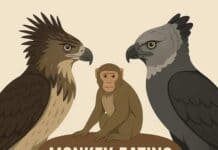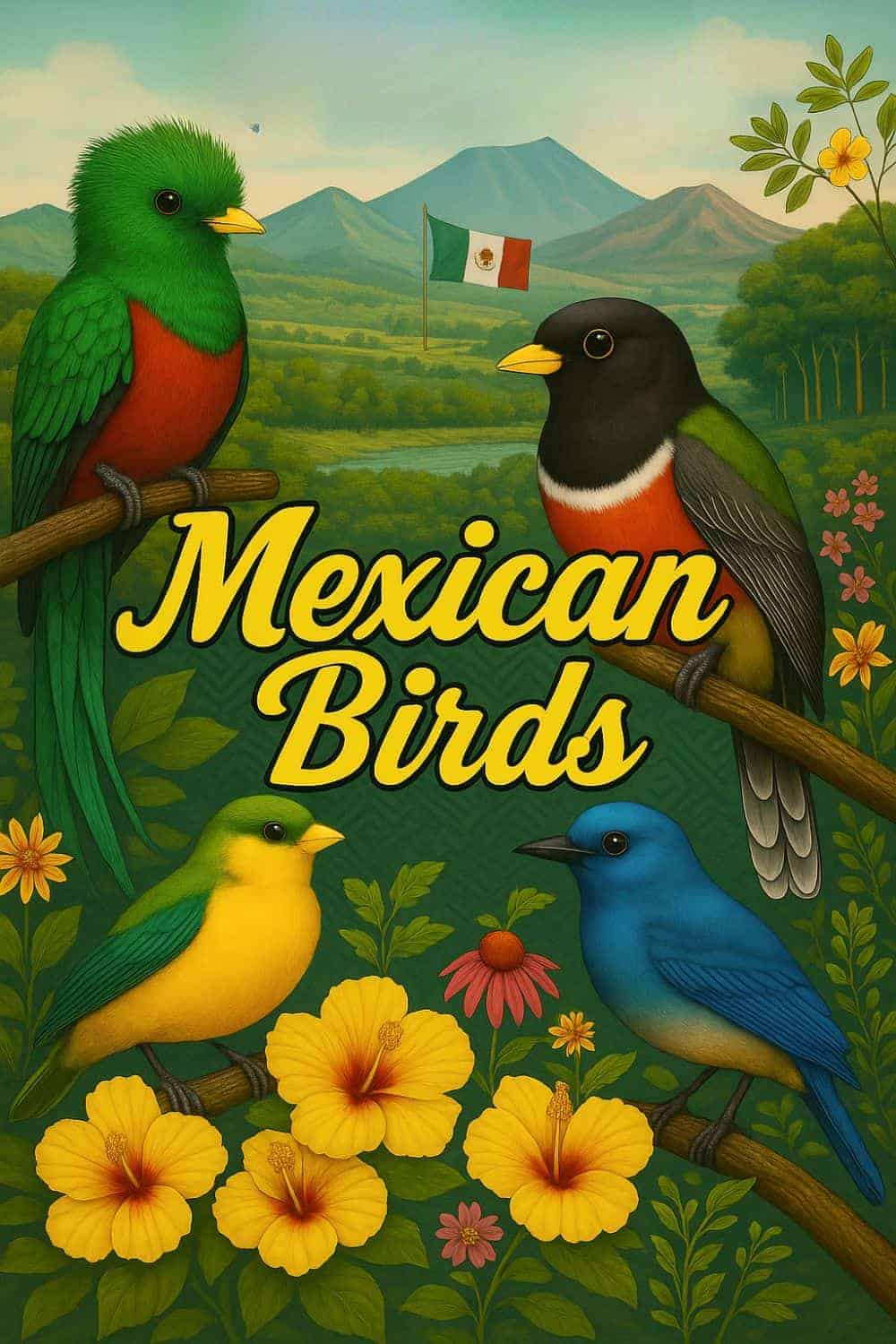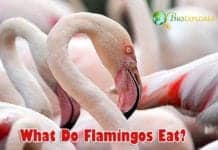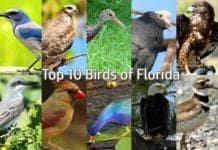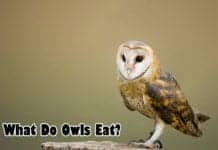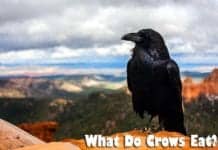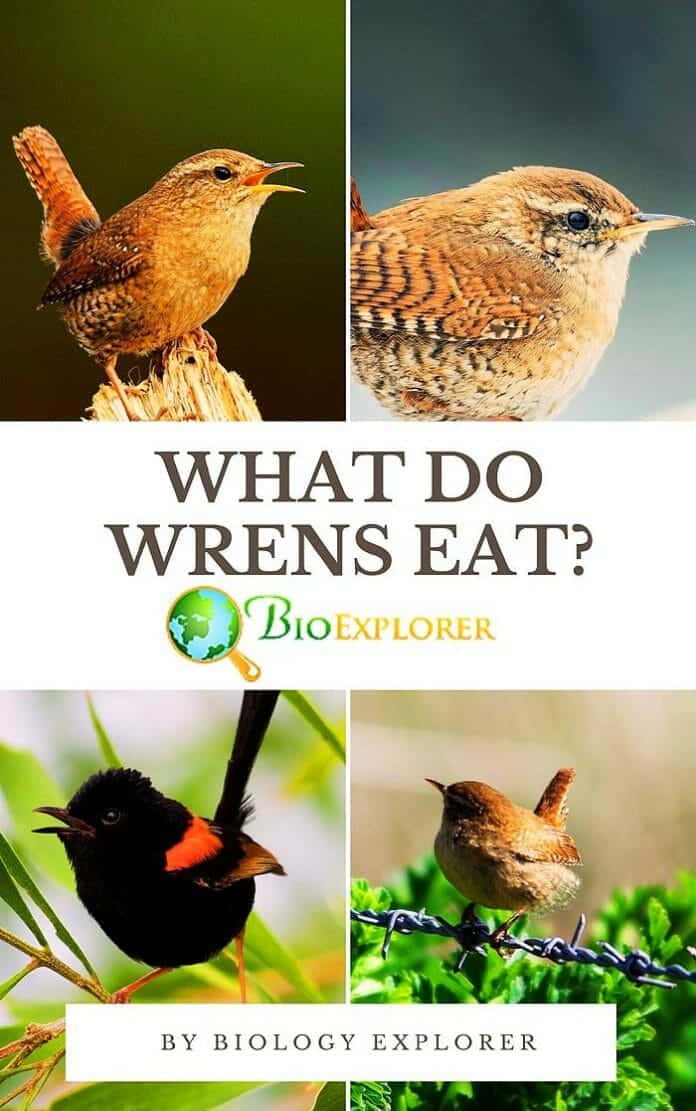
What Do Wrens Eat? Wrens are small Passeriformes that are found in wide distribution in North and South America. This bird is primarily insectivorous, meaning it mostly consumes insects. However, other wren species supplement their insect diet with plant materials, making them omnivorous.
This page will be focused on studying the diet of some of the different wren species classified under myriad genera. The intent of this article is to promote understanding of some of the wrens.
Table of Contents
- What Do Wrens Eat?
- Different Types of Wrens
- What Do Eurasian Wrens Eat?
- What Do White-headed Wrens Eat?
- What Do Tooth-billed Wrens Eat?
- What Do Nava’s Wrens Eat?
- What Do Carolina Wrens Eat?
- What Do Marsh Wrens Eat?
- When Do Wrens Eat?
- How Much Do Wrens Eat?
- How Often Do Wrens Eat?
- What Eats Wrens?
- Role in Animal Food Chain
- Are all Wrens strict insectivores?
- How do young wrens obtain their nutrients to meet their daily energy needs?
- Can wrens look for prey in unusual places?
What Do Wrens Eat?
| Eurasian Wren | Troglodytes troglodytes | Insects & their larvae, moth larvae, cabbage moth caterpillars, crane fly larvae, spiders and seeds. |
| White-headed Wren | Campylorhynchus albobrunneus | Insects (locusts, crickets, grasshoppers, and ants) |
| Tooth-billed Wren | Odontorchilus cinereum | Wide array of insects from its eco-system |
| Navas Wren | Hylorchilus navai | Variety of insects from its eco-system |
| Carolina Wren | Thryothorus ludovicianus | Insects (beetles, crickets, grasshoppers, true bugs, spiders), some snails, and millipedes, tree frogs, and lizards, seeds, small fruits, and berries. |
| Marsh Wren | Cistothorus palustris | Insects (beetles, flies, moths, spiders, grasshoppers, and caterpillars), aquatic insects (damselflies, mosquitoes, as well as their larvae) and snails. |
![]()
Different Types of Wrens
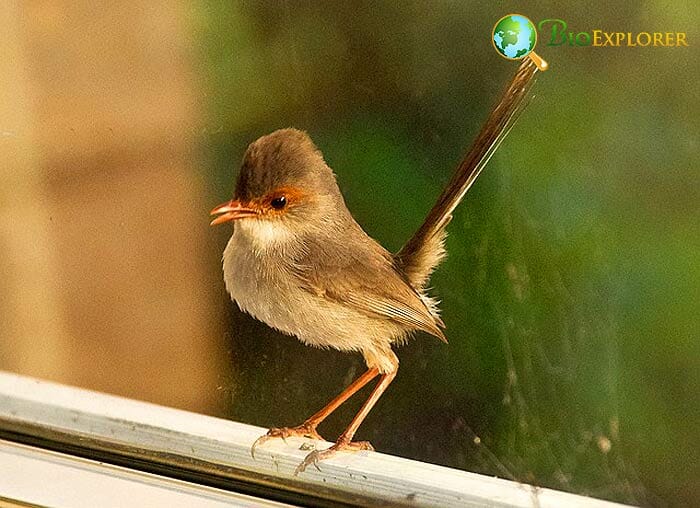
Wrens are a group of over 90 passerine bird species that make up the 19 genera of the Troglodytidae taxonomic family. Almost all of these species are exclusively distributed in the Americas, with 9 of these species in North America.
- Some of the most common wren species include the house wren, the California wren, and the winter wren. One of the most infamous traits of wrens is that they usually hold their tails firmly erect towards the sky.
- The family name “Troglodytidae” was derived from the word “troglodyte“, which refers to creatures that live in caves—in other words, cave dwellers—probably because certain species of wrens (most notably the Eurasian wren) generally hunt for their food in caves and other similar-looking places.
- In terms of physical characteristics, most wrens are pretty tiny but a bit chunky, typically ranging between 10 to 20 grams in weight, with a length of about 13 centimeters. However, like most other biological findings, there are anomalies; for example, the cactus wren, the largest wren species in the United States, usually has a length of about 20 cm and a weight that can go up to 47 grams!
- For almost all the wren species, plumage is brown and white, with some species showing some black and grey. It is also worth mentioning that most of these species have no visible difference between males and females in terms of plumage.
- In various human cultures, wrens represent different positive things. For example, many people believe that wrens symbolize spring, rebirth, and protection (perhaps since they are songbirds and are known to be peaceful). Wrens are also commonly associated with calmer activities, such as arts like poetry, singing, writing, and more.
- Finally, it should also be noted that many other bird species are called similar names: “fairy-wrens“, “grasswrens“, and “emu-wrens” are a few examples. However, it should be noted that these birds are not at all considered to be actual wrens. They are not even related to the real wrens; they are known as such regularly because they are similar (in terms of physical appearance).
Wrens are classified under 19 genera. For the purpose of this article, wrens drawn from six different genera will be explored. The birds that will be analyzed include the Eurasian wren, the white-headed wren, the tooth-billed wren, Nava’s wren, Carolina wren, and the rufous wren.
![]()
What Do Eurasian Wrens Eat?
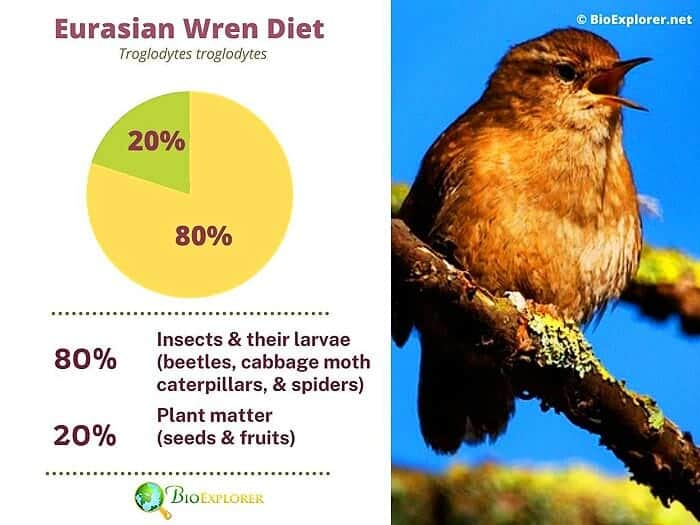
Diet: The Eurasian wren is mainly carnivorous (particularly insectivorous). Its main diet is made up of a wide variety of insects and their larvae. The juvenile ones primarily feed on moth larvae, cabbage moth caterpillars, and crane fly larvae, which helps them grow. These birds also draw their nutrition from spiders and seeds. About 80% of their diet is drawn from animal protein. The other nutrients are obtained from plant seeds.
| Animalia | Passeriformes | Troglodytidae | Troglodytes | Troglodytes troglodytes |
Hunting Techniques:  Eurasian wrens hunt for insects in the remotest parts.Their small sizes come in handy in helping them fit in the tiniest crevices to actively look for insects.
Eurasian wrens hunt for insects in the remotest parts.Their small sizes come in handy in helping them fit in the tiniest crevices to actively look for insects.
Where can it be spotted? ![]() The Eurasian wren is a commonly sighted bird throughout Europe.It can also be spotted in Northern Africa (Maghreb).
The Eurasian wren is a commonly sighted bird throughout Europe.It can also be spotted in Northern Africa (Maghreb).
![]()
What Do White-headed Wrens Eat?
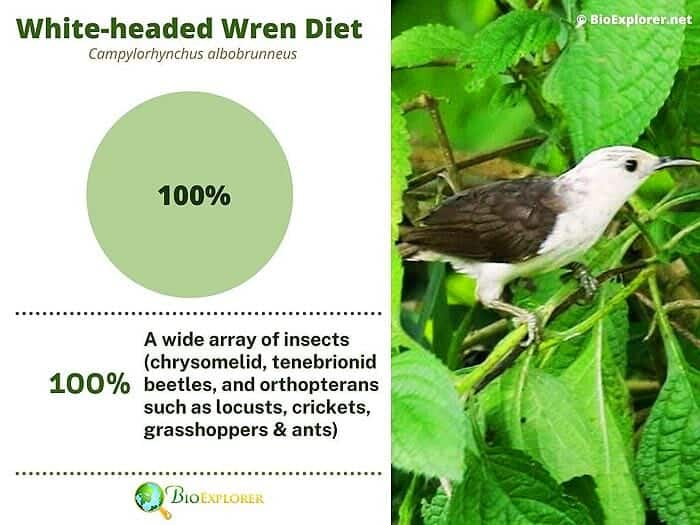
Diet: The white-headed wrens are primarily insectivorous. In fact, almost 100% of their diet is made up of insects. However, analyzed stomach contents of a subspecies of this bird (Campylorhynchus albobrunneus albobrunneus) revealed the presence of insects remains. The insects identified were chrysomelid, tenebrionid beetles, and orthopterans (an insect order containing locusts, crickets, grasshoppers, and ants).
| Animalia | Passeriformes | Troglodytidae | Campylorhynchus | Campylorhynchus albobrunneus |
Hunting Techniques:  The white-headed wren forages in groups, which is a unique strategy aimed at increasing the chances of hunting success.
The white-headed wren forages in groups, which is a unique strategy aimed at increasing the chances of hunting success.
Where can it be spotted? ![]() The white-headed wren is a common bird in South America, particularly central and eastern Panama and the western parts of Colombia.It can be easily spotted in moist lowland forests, where it commonly forages in the second growth or the upper-level forest.
The white-headed wren is a common bird in South America, particularly central and eastern Panama and the western parts of Colombia.It can be easily spotted in moist lowland forests, where it commonly forages in the second growth or the upper-level forest.
![]()
What Do Tooth-billed Wrens Eat?
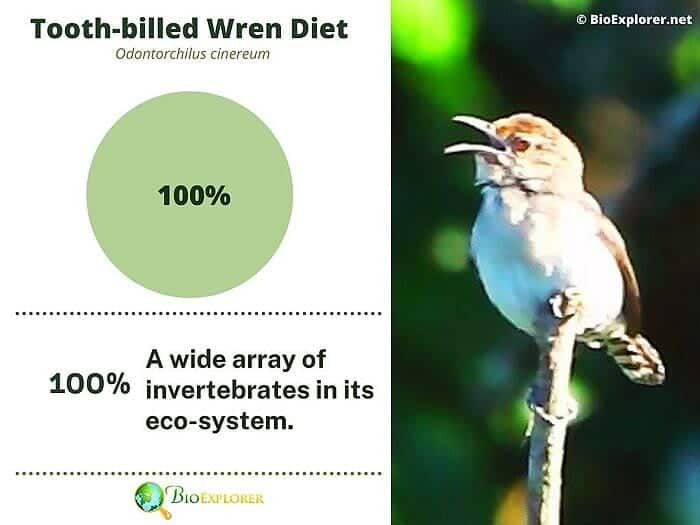
Diet: The toothed-billed wren is insectivorous, although information about its diet remains unknown. Almost 100% of its nutrients are obtained from consuming the wide variety of invertebrates found within its ecosystem.
Hunting Techniques:  The tooth-billed wren searches for food in the upper canopies.This bird will commonly be a part of a mixed flock, which is an imperative hunting strategy.Mixed species flocks increase their hunting success.
The tooth-billed wren searches for food in the upper canopies.This bird will commonly be a part of a mixed flock, which is an imperative hunting strategy.Mixed species flocks increase their hunting success.
Where can it be spotted? ![]() The tooth-billed wren can be spotted in Brazil and Bolivia, especially within the Amazonian basin.
The tooth-billed wren can be spotted in Brazil and Bolivia, especially within the Amazonian basin.
![]()
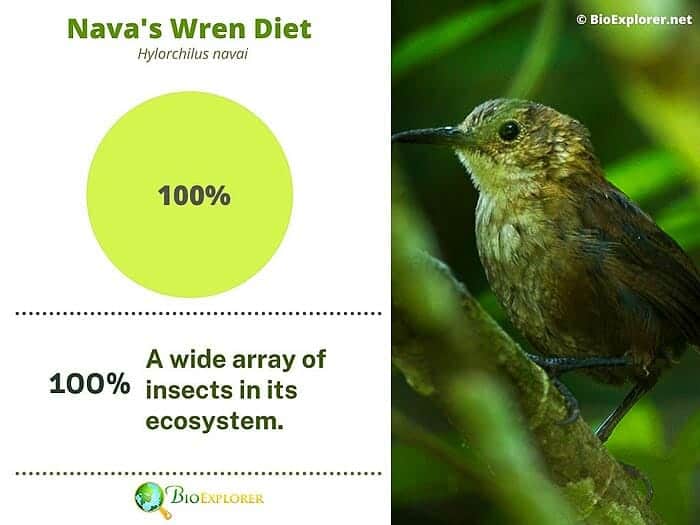
Diet: This cave-dwelling bird is carnivorous, insectivorous, often consuming insects. Almost 100% of its diet is drawn entirely from consuming insects.
| Animalia | Passeriformes | Troglodytidae | Hylorchilus | Hylorchilus navai |
Hunting Techniques:  The Nava’s wren forages 100% on the ground, rocky outcrops, and crevices.Its small size makes it capable of fitting in unreachable places to stalk prey.
The Nava’s wren forages 100% on the ground, rocky outcrops, and crevices.Its small size makes it capable of fitting in unreachable places to stalk prey.
Where can it be spotted? ![]() The Nava’s wren is endemic Mexico.Here, it is commonly found in tropical and subtropical moist lowland forests.However, it is a common sight in the southern parts of Veracruz and Chiapas.Therefore, this bird will likely be seen on or next to the ground in these areas, in limestone boulders, caves, and crevices.
The Nava’s wren is endemic Mexico.Here, it is commonly found in tropical and subtropical moist lowland forests.However, it is a common sight in the southern parts of Veracruz and Chiapas.Therefore, this bird will likely be seen on or next to the ground in these areas, in limestone boulders, caves, and crevices.
![]()
What Do Carolina Wrens Eat?
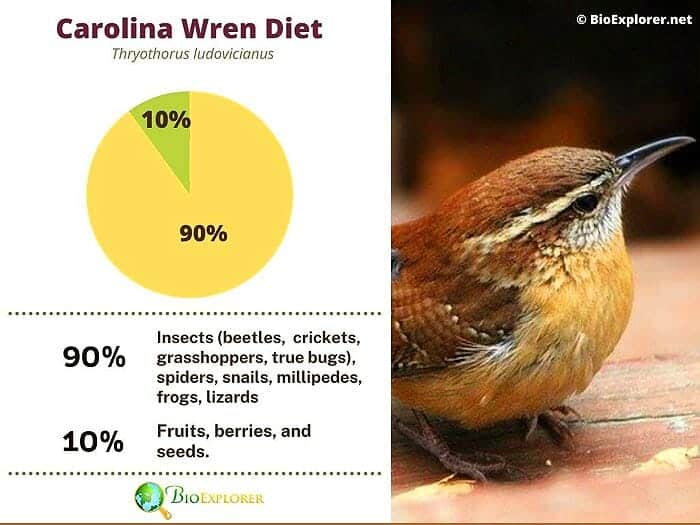
Diet: The Carolina wrens primarily feed on insects. These birds mainly feed on insects of various types, including beetles, crickets, grasshoppers, and true bugs. The Carolina wrens also eat spiders, some snails, and millipedes. These birds also consume tree frogs and lizards. When insects are hard to find during winter, Carolina wrens eat seeds, small fruits, and berries. Given the above, it is apparent that 90% of their diet is made up of animal protein, while the other 10% is supplemented by fruits, berries, and seeds.
| Animalia | Passeriformes | Troglodytidae | Thryothorus | Thryothorus ludovicianus |
Hunting Techniques:  Carolina wrens forage on or nest to the ground, where they hop along to find their prey.Their bills come in handy when hunting because they can poke it in the tiniest of crevices and hideout areas to search for their beloved insects and other invertebrates.
Carolina wrens forage on or nest to the ground, where they hop along to find their prey.Their bills come in handy when hunting because they can poke it in the tiniest of crevices and hideout areas to search for their beloved insects and other invertebrates.
Where can it be spotted? ![]() Carolina wrens were initially restricted to the southeastern parts of the United States.Presently, they can also be spotted in New England, where they can be found in all four seasons.
Carolina wrens were initially restricted to the southeastern parts of the United States.Presently, they can also be spotted in New England, where they can be found in all four seasons.
![]()
What Do Marsh Wrens Eat?
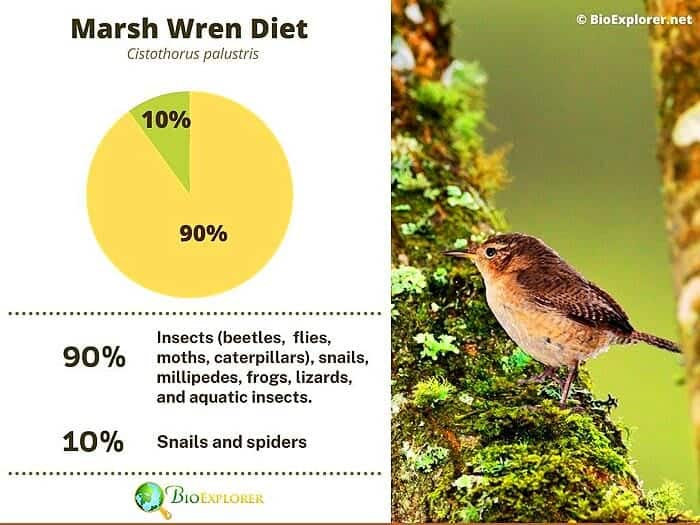
Diet: Marsh wrens are primarily carnivorous. These songbirds often dine on insects, including beetles, flies, moths, grasshoppers, and caterpillars. Marsh wrens also eat aquatic insects such as damselflies and mosquitoes, as well as their larvae. These birds have also been documented to consume snails and spiders. In general, these invertebrates make up almost 90% of their diet.
| Animalia | Passeriformes | Troglodytidae | Cistothorus | Cistothorus palustris |
Hunting Techniques:  Marsh wrens look for prey in low growths.Then, they hop on the ground, stalking and capturing insects.Marsh wrens can also pick insects from plants, stems, and even water.In other cases, these birds make short flights, and their excellent eyesight and precision help them catch insects mid-air.
Marsh wrens look for prey in low growths.Then, they hop on the ground, stalking and capturing insects.Marsh wrens can also pick insects from plants, stems, and even water.In other cases, these birds make short flights, and their excellent eyesight and precision help them catch insects mid-air.
Where can it be spotted? ![]() The marsh wren is a North American species commonly seen in the Pacific North West Coast, Puget Trough, Columbia Plateau, and Okanagan.This species can also be seen, although rarely, in the Blue Mountains and the Eastern, Northern, and Western Cascades.The marsh wren can also be rarely spotted in the Canadian Rockies.Instead, the marsh wren will commonly be sighted in bulrushes, sedges, phragmites, tidal salt marshes, and agricultural canals with weeds in these areas.
The marsh wren is a North American species commonly seen in the Pacific North West Coast, Puget Trough, Columbia Plateau, and Okanagan.This species can also be seen, although rarely, in the Blue Mountains and the Eastern, Northern, and Western Cascades.The marsh wren can also be rarely spotted in the Canadian Rockies.Instead, the marsh wren will commonly be sighted in bulrushes, sedges, phragmites, tidal salt marshes, and agricultural canals with weeds in these areas.
![]()
When Do Wrens Eat?
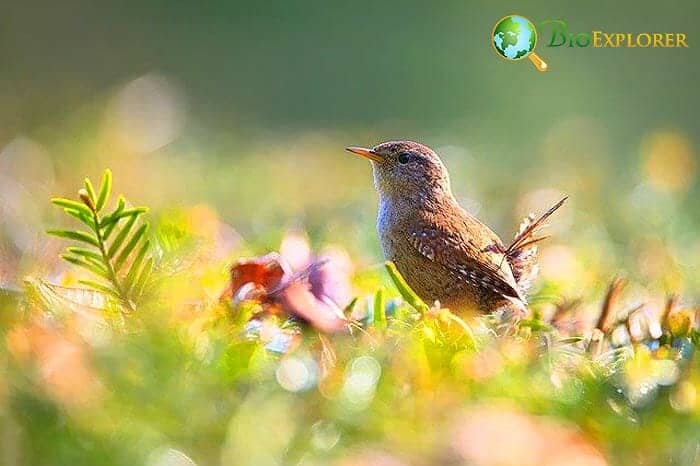
Most wrens are primarily diurnal. This means that they tend to forage during the daylight hours. During nightfall, these birds rest.
![]()
How Much Do Wrens Eat?
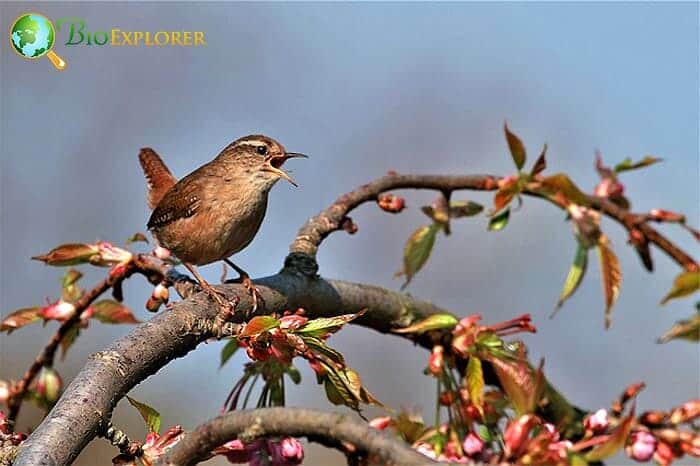
During summer, the consumption of insects and other small invertebrates is higher among wrens. · A previous study performed on wrens revealed that 94% of their stomach content was composed of insects. · The other 6% of the nutrients were obtained from plant matter. It was also noted that many wrens increase their consumption of plant food during winter. · More specifically, the proportion of plant food increases by up to 11% during winter. However, during summer, plant food consumption generally drops up to 1%.
![]()
How Often Do Wrens Eat?
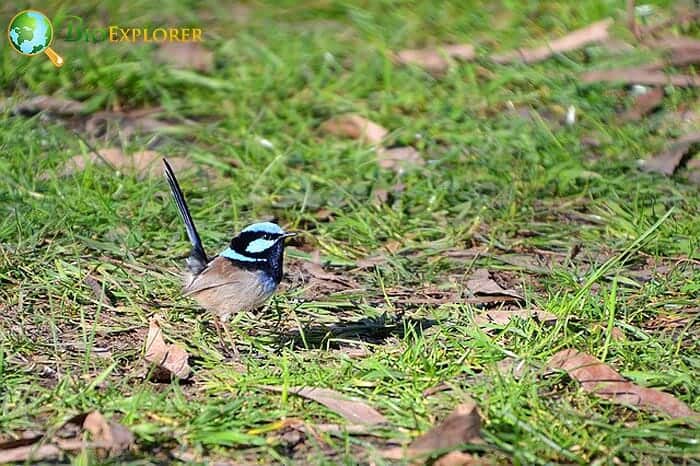
Wrens eat as much as they can as long as the food is available. However, during harsh cold winter, there tend to be food shortages and high competition for whatever food is available. In such scenarios of scarcity, wrens feed very little. Some birds are affected by food scarcity to the point that they do not make it past winter.
![]()
What Eats Wrens?
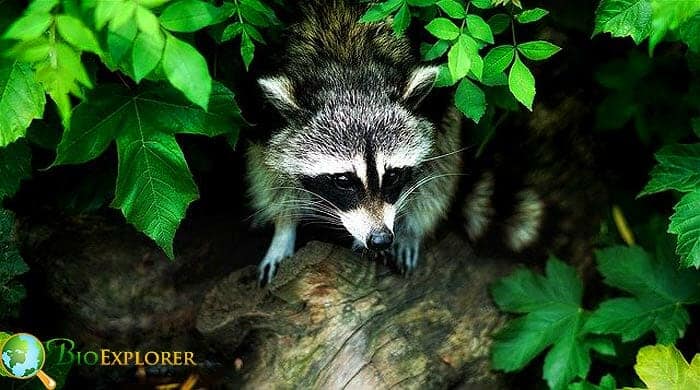
The different wren species are ideal prey to specific organisms. The individual predators of some of the Bird Species discussed above are outlined below; · Eurasian Wren- Domestic cats · Carolina Wren- The common predators of the Carolina wrens are the large birds, which include hawks and the blue jays. Their eggs are predated by minks, raccoons, eastern chipmunks, squirrels, foxes, and black rat snakes. · Marsh Wren- Marsh wrens’ eggs and nestlings are eaten by raccoons, snakes, rats, and some birds of prey.
![]()
Role in Animal Food Chain
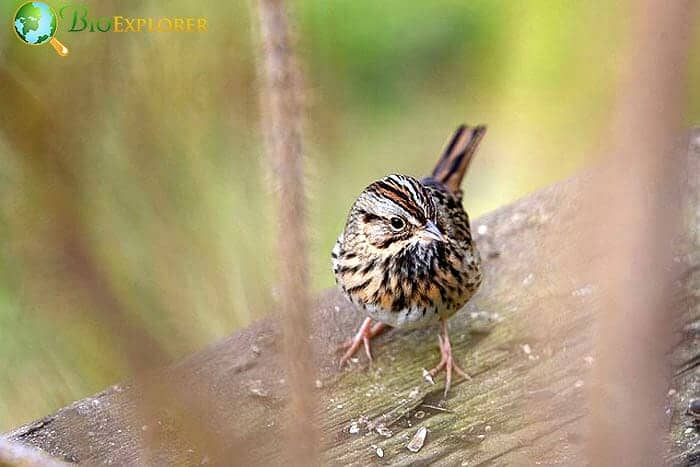
Wrens play an essential role in the animal food chain such that their absence because of issues related to habitat loss, among others, will adversely affect the stability of an ecosystem. · By consuming insects, spiders, and other small invertebrates, wrens help regulate the local populations of these organisms, thus keeping them from overpopulating. · Wrens are also ideal delicacies to organisms that predate them and their eggs, such as snakes, foxes, hawks, blue jays, and minks.
![]()
Are all Wrens strict insectivores?
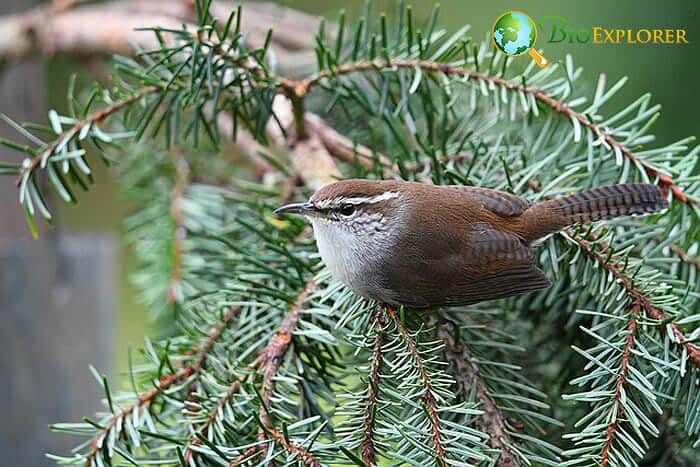
On the contrary, no. While some wrens are strict carnivores, feeding only on insects, some supplement their insect diet with plant material. Additionally, some species living next to human settlements can eat the remains of human food.
![]()
How do young wrens obtain their nutrients to meet their daily energy needs?
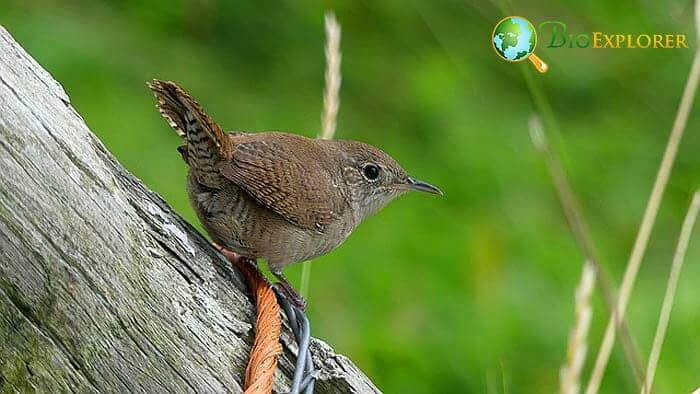
Young wrens are fed by their parents for the next 12 to 18 days of their lives, after which they leave the nest and become fully independent.
![]()
Can wrens look for prey in unusual places?
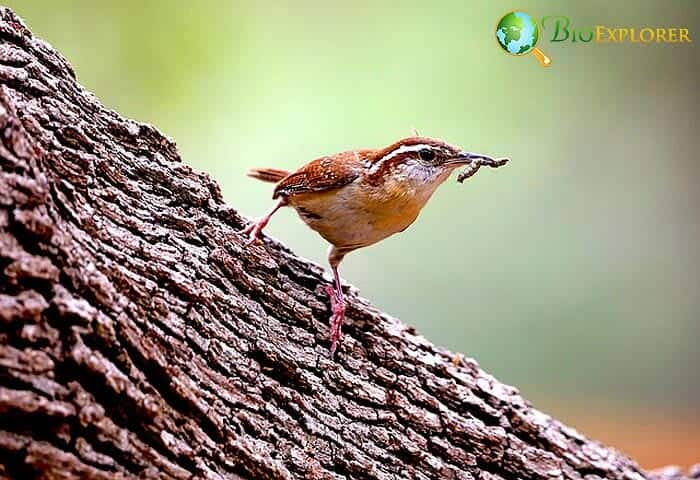
Wrens can look for their potential prey in a compost heap. By turning the pieces of trash upside down, these birds can uncover some small invertebrates that live in compost.
![]()
Wrens are found in the New World, with only one species commonly found in Europe. These birds inhabit a vast range of habitats where they consume most insects and other small invertebrates. While many of the wren species are classified as “Least Concern” organisms, some are threatened by invasive species and scenarios of habitat loss, making their populations vulnerable.
Thus, their chances of survival in the coming years appear bleak. In this regard, it makes sense to promote awareness of maintaining the ecosystem to preserve and restore many wren populations.
![]()


